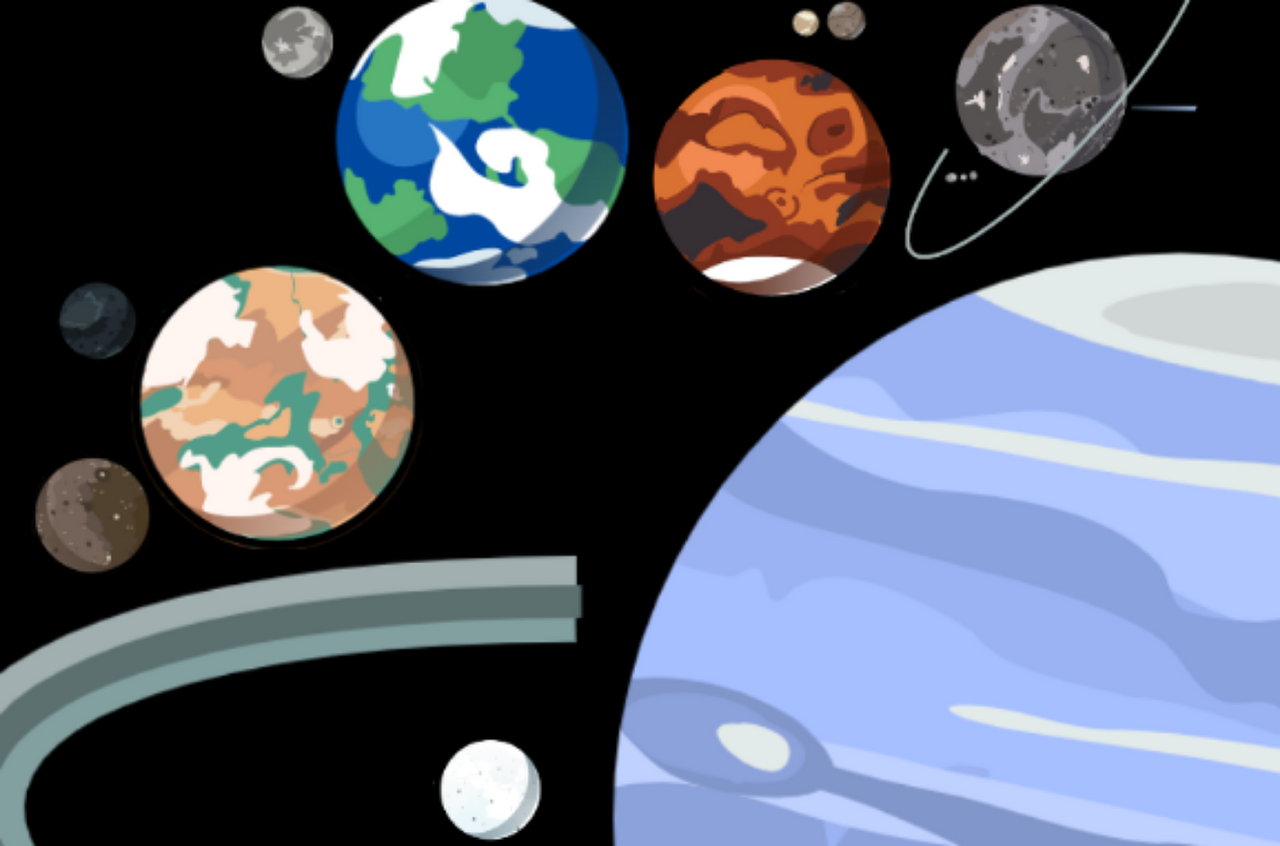HOME | DD
 SomeAT-AT — Alt History Solar System
SomeAT-AT — Alt History Solar System

#alternativehistory #ceres #mars #space #universe #venus #earth #mercury #solarsystem
Published: 2023-03-11 01:08:32 +0000 UTC; Views: 3465; Favourites: 8; Downloads: 1
Redirect to original
Description
Inspired by NizamZ7 take on an alternative solar system so I did my own take.Planets.
1. Mercury, 3,213.9 mi. Moons: 0. 0.41 AU. A Tide Locked world with the most oval shaped orbit in the system with one side burning hot and the other side freezing cold, this makes it both the hottest and one of the coldest worlds in the solar system. Mercury is the only planet without an atmosphere or magnetic field due to them being gone eons ago due to solar winds and the core cooling down, Mercury has the deepest hole in the solar system.
Biome List: North Pole, Minor Craters, Caloris Planitia, Highlands, Lowlands, Midlands, Medium Craters, Canyons, Burning Side, Frost Side, South Pole.
2. Venus, 7,820.8 mi. Moons: 1, Neith (2,267.2 mi). 0.89 AU. A Warm Desert World where the regular temperature is no hotter then a hot summer day with it's atmosphere being only a bit thicker than Terra and having areas that have lakes, canyons, saltflats, hot springs and mountains as well as having tectonic activity and being volcanically active. Venus is best known for having a single ocean, flora near lakes that can resist the heat and being the sister to Terra as well as rotating opposite to it's fellow planets. Be sure to look out for sandstorms!
Biome List: North Lake Pole, Midland Dunes, Lowland Dunes, Highland Dunes, Mountains, Giant Lakes, Venusian Ocean, Saltflats, Canals, Canyons, Volcanos, Hot Springs, Geysers, Rivers, Venusian Islands, Venusian Bloom, Juno Geyser, Northern Dunes, Southern Dunes, Quicksand Shores, Hurricane Leda, Venusian Supercontinent Aphrodite, Badlands, Shallows, South Lake Pole.
3. Terra, 7,926.5 mi. Moons: 1, Luna (2,159.1 mi). 1 AU. An Ocean Planet with green landscaping that many lifeforms including some oddly smart furry apes call home. Terra doesn't need an introduction with it's relationship with Luna, without it Terra's tides would be near nonexistent.
Biome List: North Ice Cap, Tundra, North Ice Shelf, Grasslands, Mountains, Deserts, Badlands, Islands, Shores, Minor Mountains, Shallow Waters, Tropics, Savannah, Swamps, Minor Volcanos, Forest, Lowlands, Midlands, Highlands, Terra's Ocean, Inland Water, Floodplains, Rivers, Lakes, South Ice Shelf, Steppe, Coast, Impact Basins, Temperate Regions, South Ice Cap.
4. Mars, 6,212.3 mi. Moons: 2, Phobos (992.12 mi) and Deimos (792.2 mi). 1.4 AU. The Red Planet! Mars is the 3rd most iconic planet in our solar system right side Venus and Terra. Mars redness comes from it's mildly rusty surface in certain areas and ocean bacteria making Mars seas a reddish-brown in some areas. Mars is home to many big things such as the biggest ice caps of any planet, biggest canyon and biggest volcano that's thankfully inactive. Mars tides are known to be extreme due to it's two moons working together to make massive waves that can flood areas of the land.
Biome List: North Ice Cap, Tundra, Water Basins, Lowlands, Midlands, Highlands, Valles Marineris, Olympus Mons, Minor Volcanos, Rivers, Mars Ocean, Fungal Forest, Blacksand Desert, Blacksand Highland Dunes, Blacksand Lowland Dunes, Mountains, Minor Mountains, Islands, Lakes, Fungallands, Shores, Coast, Rusted Lakes, Eolian Plains, Impact Basins, Canyons, Shallow Waters, Canals, South Ice Cap.
5. Ceres, 5,101.2 mi. Moon: 3, Vesta, (326.47 mi), Hygiea (275.89 mi) and Pallas (338.65 mi). 2.2 AU. Ceres Definitely stands out from it's siblings. Ceres has a mildly thin atmosphere of mostly Water Vapor, Methane and Carbon Dioxide with a wide equatorial ridge. Ceres is also one of two planets with a ring system as well as having many features such as an underwater salty ocean under it's crust, the tallest cliff in the solar system, an axle being tilted 88 degrees, cryovolcanos who's plumes can shoot up 100s of miles and having bright spots known as faculae on the more rocky areas on it's surface. Ceres oddly inclined orbit, fast 9 hour backwards rotation, wack axle tilt and it's moons looking like chunks of itself highly imply it had a very troubled past in the early solar system.
Biome List: North Pole, Craters, Highlands, Midlands, Lowlands, Mountains, Hills, Ice Canyons, Great Ceres Ridge, Cyrovolcanos, Ahuna Mons, Northern Glaciers, Facula, Tholi, Frossa, Ice Fields, Cliff Achita, Ice Sheets, Lineae, Fractured Ice, Fragile Ice, South Pole.
6. Janus, 22,998 mi. Moons: 6 Major, 13 Minor. Tethys, (2,854.3 mi) Hebe, (1,101.5 mi) Chronos, (1,692.9 mi) Iris, (1,522.9 mi) Eros, (931.1 mi) and Juno (705.5 mi). 3.6 AU. After the Astroid Belt between Mars and Ceres lies the small gas dwarf Janus, the biggest planet in the solar system as well as the eldest only forming a few 50 million years before the others. Janus is known for it's powerful winds that can go over 1,000 MPH and strong gravity able to hold 5 major natural satellites without sweat as well for having rings that put little oddball Ceres to shame. Tethys, Janus's biggest moon, and biggest in the system is known for being the most bright moon in the system.
Biome List: Equatorial Belt, Polar Northern Tristorm, Storms, Temperate Belts, Irregular Belts, Sub Equatorial Belts, Storm of Ra, Ra Jr., White Line Storms, Polar Southern Region.
The Sun is basically the same. Boring...
























